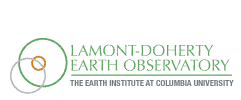|
Recent MARGINS Books
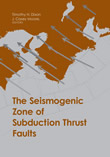 |
The Seismogenic Zone of Subduction Thrust Faults
Edited by Timothy H. Dixon and J. Casey Moore
Columbia University Press, September 2007, MARGINS Theoretical and Experimental Earth Science Series, Volume 2, cloth,
692 pages,
10 tables, 242 figures, and 3 plates, ISBN: 978-0-231-13866-6
Subduction zones, one of the three types of plate boundaries, return Earth's surface to its deep interior. Because subduction zones are gently inclined at shallow depths and depress Earth's temperature gradient, they have the largest seismogenic area of any plate boundary. Consequently, subduction zones generate Earth's largest earthquakes and most destructive tsunamis. As tragically demonstrated by the Sumatra earthquake and tsunami of December 2004, these events often impact densely populated coastal areas and cause large numbers of fatalities.
While scientists have a general understanding of the seismogenic zone, many critical details remain obscure. This volume attempts to answer such fundamental concerns as why some interplate subduction earthquakes are relatively modest in rupture length (greater than 100 km) while others, such as the great (M greater than 9) 1960 Chile, 1964 Alaska, and 2004 Sumatra events, rupture along 1000 km or more. Contributors also address why certain subduction zones are fully locked, accumulating elastic strain at essentially the full plate convergence rate, while others appear to be only partially coupled or even freely slipping; whether these locking patterns persist through the seismic cycle; and what is the role of sediments and fluids on the incoming plate.
Nineteen papers written by experts in a variety of fields review the most current lab, field, and theoretical research on the origins and mechanics of subduction zone earthquakes and suggest further areas of exploration. They consider the composition of incoming plates, laboratory studies concerning sediment evolution during subduction and fault frictional properties, seismic and geodetic studies, and regional scale deformation. The forces behind subduction zone earthquakes are of increasing environmental and societal importance.
Buy This Book |
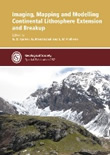 |
Imaging Mapping and Modelling Continental Lithosphere Extension and Breakup
Edited by G D Karner, G Manatschal and L M Pinheiro
The Geological Society, GSL Special Publications, 5 July 2007, 488 pages, hardbound, ISBN: 1-86239-228-5
•Imaging, mapping and modelling continental lithosphere extension
and breakup: an introduction, G D Karner, G Manatschal and L M
Pinheiro
• Break-up of the Newfoundland-Iberia rift, B E Tucholke, D
S Sawyer and J-C Sibuet
• Structure of the Flemish Cap margin,
Newfoundland: insights into mantle and crustal processes during
continental breakup, J R Hopper, T Funck and B E Tucholke
• Early
Cretaceous motion of Flemish Cap with respect to North America:
implications on the formation of Orphan Basin and SE Flemish
Cap-Galicia Bank conjugate margins, J-C Sibuet, S P Srivastava, M
Enachescu and G D Karner
• The formation of non-volcanic rifted
margins by the progressive extension of the lithosphere: the
example of the West Iberian margin, T J Reston
• Roles of
lithospheric strain softening and heterogeneity in determining the
geometry of rifts and continental margins, R S Huismans and C
Beaumont
• The role of gravitational instabilities, density structure, and extension rate in the evolution of continental margins, E Burov
•
A dynamic model of rifting between Galicia Bank and Flemish Cap
during opening of the North Atlantic Ocean, D L Harry and S
Grandell
• A kinematic modelling approach to lithosphere deformation
and basin formation: application to the Black Sea, S S Egan and D J
Meredith
• Early kinematic history of the Goban Spur rifted margin
derived from a new model of continental breakup and sea-floor
spreading initiation, D Healy and N J Kusznir
• The boundary
between continental rifting and seafloor spreading in the Woodlark
Basin, Papua New Guinea, A M Goodliffe and B Taylor
• Nature of
the continent-ocean transition zone along the southern Australian
continental margin: a comparison of the Naturaliste Plateau, SW
Australia, and the central Great Australian Bight sectors, N G
Direen, I Borissova, H M J Stagg, J B Colwell and P A Symonds
•
Constraints on the deformation and rupturing of continental
lithosphere of the Red Sea: the transition from rifting to drifting, J R
Cochran and G D Karner
• Observations from the Alpine Tethys and
Iberia Newfoundland margins pertinent to the interpretation of
continental breakup, G Manatschal, O Muntener, L L Lavier, T A
Minshull and G Peron-Pinvidic
• Overview of tectonic settings
related to the rifting and opening of Mesozoic ocean basins in the
Eastern Tethys: Oman, Himalayas and Eastern Mediterranean
regions, A H F Robertson
• Continental lithospheric thinning and
breakup in response to upwelling divergent mantle flow: application
to the Woodlark, Newfoundland, and Iberia margins, N J Kusznir G D
Karner
• Observations from the Basin and Range Province (western
United States) pertinent to the interpretation of regional detachment
faults, N Christie-Blick, M H Anders, S Wills, C D Walker and B
Renik
• Effects of initial weakness on rift architecture, S
Dyksterhuis, P Rey, R D Müller and L Moresi
• Incompressible
viscous formulations for deformation and yielding of the lithosphere,
L Moresi, H-B Muhlhaus, V Lemiale and D May
Buy This Book |
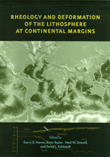 |
Rheology and Deformation of the Lithosphere at Continental Margins
Edited by Garry D. Karner, Brian Taylor, Neal W. Driscoll, and David L. Kohlstedt
Columbia University Press, February, 2004, 384 pages, 75 illus., ISBN: 0-231-12738-3
- Consequences of Asthenospheric Variability in Continental Rifting - W. Roger Buck View Summary
- Velocity Fields, Faulting and Strength on the Continents - James Jackson View Summary
- Low-Angle Normal Fault Mechanics and Crustal Strength - Gary J. Axen View Summary
- Depth-Dependent Lithospheric Stretching at Rifted Continental Margins - Mark Davis and Nick Kusznir View Summary
- Limits of the Seismogenic Zone - Larry J. Ruff View Summary
- Controls on Subduction Thrust Earthquakes: Downdip Changes in Composition and State - R. D. Hyndman View Summary
- Thermo-Mechanical Models of Convergent Orogenesis: Thermal and Rheologic Dependence of Crustal Deformation - Sean D. Willett and Daniel C. Pope View Summary
- Structure of Large-Displacement, Strike-Slip Fault Zones in the Brittle Continental Crust - F. M. Chester, J. S. Chester, D. L. Kirschner, S. E. Schulz, and J. P. Evans View Summary
- Fiction, Friction, and the San Andreas Fault - Christopher H. Scholz and Thomas C. Hanks View Summary
- Deformation Behavior of Partially Molten Mantle Rocks - YaQin Xu, M. E. Zimmerman, and D. L. Kohlstedt View Summary
- Relations Among porosity, Permeability, and Deformation in Rocks at High Temperatures - Brian Evans, Yves Bernable, and Greg Hirth View Summary
Buy This Book
Access Columbia University Press advertisement on this book (PDF file). |
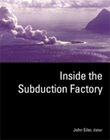 |
Inside the Subduction Factory
John Eiler, Editor View Introduction
Geophysical Monograph Series, Volume 138, 2004, 324 pages, hardbound, ISBN: 0-87590-997-3, AGU Code GM1389973
Section I: The Subducted Slab
- Thermal Structure and Metamorphic Evolution of Subducting Slabs - Simon M. Peacock View Abstract
- Tracers of the Slab - Tim Elliott View Abstract
- Basic Principles of Electromagnetic and Seismological Investigation of Shallow Subduction Zone Structure - George Helffrich View Abstract
Section II: The Mantle Wedge
- Seismological Constraints on Structure and Flow Patterns Within the Mantle Wedge - Douglas A. Wiens and Gideon P. Smith View Abstract
- Rheology of the Upper Mantle and the Mantle Wedge: A View From the Experimentalists - Greg Hirth and David Kohlstedf View Abstract
- Experimental Constraints on Melt Generation in the Mantle Wedge - Glen A. Gaetani and Timothy L. Grove View Abstract
- Mapping Water Content in Upper Mantle - Shun-ichiro Karato View Abstract
Section III: Focus Regions
- Volcanism and Geochemistry in Central America: Progress and Problems - M. J. Carr, M. D. Feigenson, L. C. Patino, and J. A. Walker View Abstract
- An Overview of the Izu-Bonin-Mariana Subduction Factory - Robert J. Stern, Matthew J. Fouch, and Simon L. Klemperer View Abstract
- Along-strike Variation in Lavas of the Aleutian Island Arc: Genesis of High Mg# Andesite and Implications for Continental Crust - Peter B. Kelemen, Gene M. Yogodzinski, and David W. Scholl View Abstract
Section IV: Synthesis
- Some Constraints on Arc Magma Genesis - Yoshiyuki Tatsumi View Abstract
- Thermal Structure due to Solid-State Flow in the Mantle Wedge Beneath Arcs - Peter B. Kelemen, Jennifer L. Rilling, E. M. Parmentier, Luc Mehl, and Bradley R. Hacker View Abstract
Buy This Book |
Natures Pharmacy
|






